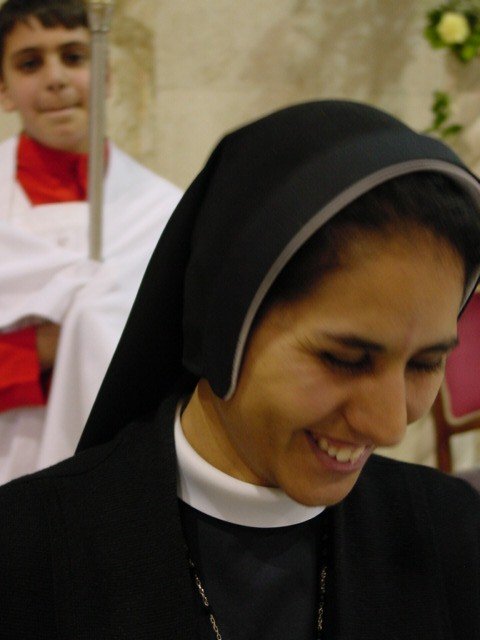August 3, 2003
We will miss Sister Nadia in Zababdeh!
Elizabeth worshipped at the Latin Church of the Visitation, at the end of which it was announced that Sister Nadia was moving to another parish. A representative of the church council presented her with an icon and Jesus and Mary as a farewell gift. We're fond of all the Rosary Sisters, and we'll miss Sister Nadia very much. Still no one knows where she'll go, although Sister Isabel suggested it might be Birzeit. If so, we'll be sure to visit her there.
After church, Elizabeth caught a shared taxi and made her way back to our home away from home away from home. The ride was very hot and dusty and long. At Hamra, two of the passengers (who didn't have the special permissions required of Palestinians to move about) got out as we were waiting in line. After an hour or so, it was our car's turn. We all got out of the car and handed in our IDs. After some time checking all the bags and our IDs, we were allowed to go through.
Around a bend in the road, we picked up the two who left us before the checkpoint. They told us how they had walked through, one pretending to be very sick. "Where are you going?" asked the soldier.
"He's sick - he needs to go to the hospital," said one of the men as the other held his head and stomach.
"What? Are you crazy? How will you get there from here?"
"I don't know but we have to go. He's very sick!"
The soldier shrugged and waved them through. And we were on our way, arriving at Qalandia without any more stops. From there, Elizabeth passed the checkpoint to Ramallah and a series of shared taxis took her to Star Mountain, where a shower was much appreciated.
Marthame, meanwhile, preached at Redeemer Lutheran Church's English-speaking congregation in Jerusalem. Among the congregation was a visiting delegation of the Christian Peacemaker Teams. They were headed off on a tour of the Wall led by the Israeli Committee Against Home Demolitions, and had an extra seat on the bus. Marthame jumped aboard gratefully though without the camera - that had been left behind with Elizabeth in Zababdeh (we are waiting for copies from the delegation and will put them up on the site as soon as we get them).
The first stop was the village of Mas'ha, where a number of organizations have set up a peace camp in protest of the Wall. They all echo what we've heard many times - should the Wall be built along the Green Line, there would be much less outcry. Instead, it is being built to confiscate as much land as possible and to protect as many settlements as possible. The most likely route of the Wall (as Israeli journalists have discovered) will mean that fifteen settlements will be given up - the other 150, however, will stay and be given room to grow. Palestinians, meanwhile, will be caged off into densely-populated ghettos, most of their agricultural land outside the Wall.
In Mas'ha, two sections of the Wall will come together - one snakes around to include several Israeli settlements and Palestinian agricultural land on the Israeli "side." On the other side, a home on the outskirts of Mas'ha is in trouble. The neighboring settlement of Elkanah runs right alongside their property - thus the Palestinian home will fall in the no-man's land between the Wall and the electrified fence. The army has promised not to destroy the house and to allow the family to stay. Twice a day they will be allowed to pass in and out, imprisoned without crime. Rumors were circulating that today the family's barn would be destroyed, and activists - particularly Israeli Jews - came to chain themselves to the barn. The contractor promised not to touch it for another month, and the group retired to consider what to do next. They discussed the possibility of moving their tent to block the path of the Wall, but this was ruled out - far too confrontational. The goal, instead, was to protect this home, not to provoke confrontation. For groups that have been much maligned, particularly like the International Solidarity Movement, such deliberations point to a broader portrait. Meanwhile, the family's water supply was cut several days earlier during the construction further down the hill.
Being here was also a chance to see what the Wall looks like. In some places its a tall concrete wall - in others, an electrified fence. On both sides are army patrol roads and ten-foot ditches filled with rolls and rolls of razor wire. Those who have deeds to agricultural land outside their prison will be allowed in and out twice a day to harvest - only those whose name is on the deeds, that is, and not allowed to bring donkeys or carts with them. One person hand-harvesting. Three years of absenteeism and the old Ottoman laws kick in, such that the land becomes property of the State. We've heard many talks and a great deal of information about the Wall, but it doesn't really sink in until you see it first-hand for yourself just how wrong-headed the whole enterprise is.
From there, it was off to see the cities of Tulkarem and Qalqilya, where the Wall first originated. Particularly there, the situation could more appropriately be described a prison. High concrete walls, guard towers placed all along. In order to include nearby settlements on the Israeli "side," Qalqilya has been isolated such that it has one entry gate coming and going. It is already estimated that one fourth of the city's population has left - voluntary transfer at work. The situation at Tulkarem is slightly better, but it's hard to imagine what worse would look like.
Marthame got back to Star Mountain, dirty and not a little bit discouraged.

